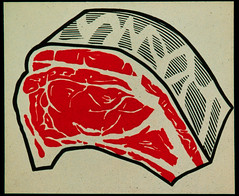My wife has been sick for several weeks. She had a cold that turned into a bad sinus infection and has been suffering from it for a couple of weeks. Antibiotics didn’t help and although she’s getting better, I’ve been trying to make a lot more spicy food of late in the hopes that the heat will help to temporarily unclear her sinuses. We had done some hot and sour soups and various Thai dishes and decided today to do Indian food. I love Indian food and actually cook a fair amount of it at home, but not always in the summer since a lot of the Indian dishes I like require long simmers.
Since it’s not too hot here I decided to make a truly spicy dish that I love: Pork Vindaloo. Vindaloo, to many people, is synonymous with anything Indian that’s insanely hot, but it is a specific dish with an interesting history. The dish was developed in Goa, which was a Portuguese colony for several hundred years. Vindaloo is traditionally made with pork, which is unusual in Indian cooking and uses vinegar which is another non-traditional ingredient. It is a spicy dish, even by Indian standards, but some of the heat comes from mustard oil and the vinegar helps to accentuate the spice of the chiles. Vindaloo also uses some sweeter spices like cinnamon and cardamom, which is reminiscent of the Moorish influence in Iberian cooking.
The basic recipe calls for creating a spice blend of cumin, cinnamon, chiles, mustard seeds, fenugreek (in many versions), and black pepper. This is mixed with vinegar and the meat is marinated in the resulting paste. Later it is cooked with onions, more chiles, garlic, cardamom and occasionally ginger. The resulting dish is spicy but slightly tart form the vinegar bit also sweet from the spices. It’s a definite head clearer and I thought it would be good for my wife’s sinuses.
On the side I planned to have basmati rice, pepper rassam, a fresh mango chutney and tomato chat masala. Pepper rassam is like a thin soup made with toor dal, onions, and tomato and is spiced with chiles, cumin and mustard seeds and is soured with tamarind. It’s delicious on its won or over rice. The mango chutney would be fresh mangoes, with shallots, lime juice, chile and mint. The tomato chat masala is fresh cherry tomatoes tossed with a spice blend that consists of cumin, chiles, black salt (which has a distinct sulfur taste but is still salt, mango powder (which is actually tart), and black pepper. This would spice the tomatoes but not overwhelm them.
There’s a lot of debate about what beers or wines go with very hot and spicy food. I used to try a lot of things, like pilsners, weiss beers, Belgian goldnes and saisons, but to truly beat the spice and heat nothing beats sweeter darker beers like bocks, Oktoberfests, and Baltic porters. Sugar cuts chile heat like nothing else. The one who enlightened me to this fact was Alan Sprints from Hair of the Dog Brewing. Several years ago on our list serve, someone asked what to serve with a traditional Mexican meal. Opinions varied, but Alan insisted on dark sweeter beers. I tried it and he is in fact correct. Hoppy beers (without the sweetness) don’t cut it. Dry beers like Saison Dupont or Duvel don’t cut it. Malt sugar counteracts chiles like nothing else.
Not having any of these beers on hand, I went to look for some German Doppelbocks, as well as some Baltic porter. Both are well suited to hot food. Unfortunately, it can be hard to find fresh examples of both. I was able to find an Aktienbrauerei Doppelbock and am Obolon Porter from Lithuania. Both were good with the food. I’ll be honest the subtleties of the beer were overwhelmed by the spice, but the body and sweetness made both quite nice with the food. The Doppelbock was all about deep rich maltiness. The porter had good dark fruit flavors, as well as an intense molasses and dark sugar flavor. Both were over 7% alcohol and had enough to stand up to the spiciness of the food.
Don’t believe it? Next time you have spicy food, dump the lighter hoppy beers in favor of a good sweet dark beer. You’ll likely be surprised by how well the beer and food come together.
Saturday, September 1, 2007
Vindaloo and Doppelbock
Posted by
Bill
at
8:10 PM
![]()
![]()
Labels: baltic porter, doppelbock, vindaloo
Subscribe to:
Post Comments (Atom)

No comments:
Post a Comment